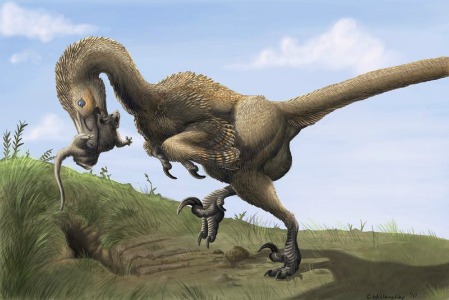Behold the roast turkey jammed with stuffing, or better yet deep-fried in one big sleek pot fired up and humming like a jet turbine on full afterburner. Smoked is good too! And it’s a great choice for a feast, the turkey has an illustrious history. In fact, Ben Franklin felt one humble member of genus Meleagris deserved wider recognition:
For in Truth the Turkey is in Comparison a much more respectable Bird, and withal a true original Native of America… He is besides, though a little vain & silly, a Bird of Courage, and would not hesitate to attack a Grenadier of the British Guards who should presume to invade his Farm Yard with a red Coat on.
How birds may have evolved from diapsid reptiles better known as dinos is a fascinating topic way beyond my limited expertise. I do know much of the fossil work has looked at feather evolution thanks to some beautifully preserved and rare fossils showing quilled dinosaurs. But if you get to slice the bird this year, and you feel like having a moment of science clarity, cut through the drum stick and you may notice Tom Turkey has another feature uniquely refined in birds: hollow, pocketed bones. And that feature is as important to bird evo as feathers if not more so.
A little over 250 million years ago the climate of earth shifted, dramatically. Temperatures across the super continent Pangea rose, land and sea became desert, oxygen levels fell sharply, life was smothered. A handful of mammal-like reptiles, our ancestors, survived in part by enhancing respiratory efficiency by evolving a diaphragm. But another group of reptiles went a step further, they developed turbochargers to zip through the great dying of the Permian-Triassic extinction.
Human lungs are like a bellows, breathing in and out, they expend half the respiratory cycle expelling stale air, laden with carbon-dioxide and robbed of oxygen. The same is true of most quadrupeds. But these ingenious survivor reptiles fighting for life in the P-T bottleneck developed a second set of lungs in their bones! Tiny pockets riddled the ancient bones, and they could link up until their aggregate volume was large enough to store a lungful of fresh air. With some creative plumbing those pockets could work in concert with the lungs, the end result was fresh air flowing over the oxygen absorbing tissue when the critter inhaled andexhaled. The new reptiles were cheating, they got a lot more oxygen per cycle than us hairy rats. With all the moving parts it’s not easy to visualize this system, but the schematic below where balloon-like sacs stand in for the tiny air pockets may help.
Our ancestors seemed to developed diaphragms around this same time, that may have been the proto mammal response to decreased O2, but the super lungs were better in lots of ways. With that kind of advantage it’s no wonder these inventive reptiles were out of the evolutionary gate fast and off running in the ruined world left behind by the P-T event. The new creatures, which we would recognize as early dinosaurs, soon dominated the shattered biome, they grew larger and began radiating into the same eco-niches filled by lions, antelope, mammoth, or bears today. The only real downside of the lung-bone set up was it made the animal prone to respiratory infections spreading to the bone and on through the body.
Eventually nature repaired the waste left behind by the P-T. Earth grew luxuriant, oxygen levels rose. And some dinos got huge. The largest land that ever roamed dry land evolved in this time, beginning in the early Jurassic about 200 million years ago. No doubt super efficient lungs taking advantage of recovering oxygen levels helped make that possible. And these animals were like nothing on earth today, living in the grey region between warm and cold-blooded. Thanks to those lungs and hollow bones, some could probably rest like a lizard, but still power up and run like an ostrich at a moments notice when needed. That same design fueled another evolutionary jump.
Flying takes lots of energy. The atrophied flight muscles of the turkey, the tender white breast meat that makes such good sandwiches, are one consequence of bird evolution. But those muscles would be powerless without the oxygen delivered by the unique respiratory super-chargers evolved 200 million years ago. Feathers are important, but the metabolic infrastructure that made birds possible evolved mountains much earlier. Without those super lungs, birds would never have existed, and there would be no turkey for you and turkey for me today. So let’s all breathe … and have a Happy Thanksgiving!


Wow. I’d never heard about the double-respiratory thing before. I’m thankful this thanksgiving that there’s so much more still left to learn!